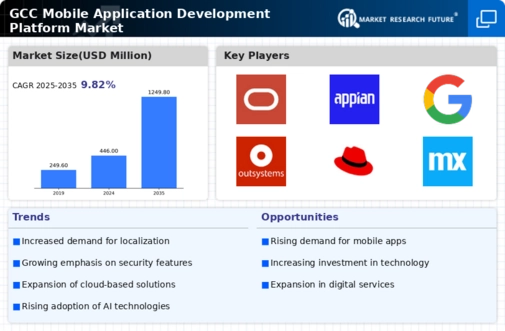The GCC Mobile Application Development Platform Market is characterized by a rapidly evolving landscape where innovation and efficiency are paramount. Key players in this market have adopted diverse strategies to maintain competitiveness and enhance their technological offerings. As organizations across various sectors seek to develop and deploy mobile applications rapidly, the competition has intensified, with companies leveraging cutting-edge technologies such as artificial intelligence, machine learning, and low-code development to provide comprehensive solutions. The integration of mobile application development platforms with cloud services is also becoming a crucial competitive factor, enabling faster deployment and scalability for enterprises.
Competitors continuously analyze market trends, consumer behavior, and emerging technological advancements to refine their platforms, ensuring they meet the dynamic needs of businesses in the GCC region.Oracle stands as a formidable competitor in the GCC Mobile Application Development Platform Market, recognized for its robust infrastructure and comprehensive solutions tailored for organizations looking to streamline their mobile strategies. With a strong presence in the region, Oracle's platform is known for its scalability, security, and ease of integration with existing enterprise systems. The company's strengths lie in its ability to provide end-to-end mobile development solutions, enabling businesses to create highly functional and user-friendly applications. Oracle's strong partnership ecosystem within the GCC supports its commitment to delivering innovative new features and capabilities. In addition to its powerful platform offerings, Oracle’s commitment to research and development ensures the constant enhancement of its services, enabling clients to leverage the latest technology and best practices in mobile application development.
Appian is also a key player in the GCC Mobile Application Development Platform Market, known for its low-code application development platform that empowers businesses to rapidly build and deploy applications with minimal coding expertise. Appian's market presence is bolstered by its focus on delivering innovative solutions that enhance business processes and drive digital transformation across various industries in the GCC. The company is renowned for its strengths in workflow automation and integration capabilities, allowing organizations to streamline operations efficiently. Key products and services offered by Appian in this region include process automation tools and mobile-ready applications, making it easier for companies to adapt to changing market demands. Furthermore, Appian has engaged in strategic partnerships and mergers that expand its footprint and enhance its technological capabilities within the GCC, ensuring it remains competitive in a market that increasingly values agility and responsiveness.

























Leave a Comment